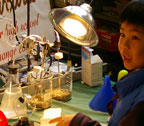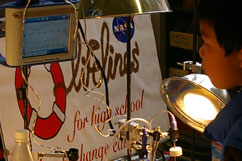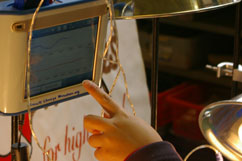

Avoiding Flawed
Demonstrations:
Greenhouse Effect
Intro/Index
Faulty Demos
Errors, Misconceptions
Testing, Lab Results
Scientifically Strong
Resources
Rebuttals
Acknowledgements
Contact

Demonstrations of this
basic design have been
addressed in a paper
published in May 2010.
American Journal
of Physics,
by
Wagoner, Liu and Tobin
From Page 1 of the Dec
2010/
Jan 2011 issue of
NEED's
Newsletter
Energy Exchange:
“NEED LAUNCHES
TWO NEW
WORKSHOPS:
EXPLORING
CLIMATE
CHANGE AND
CARBON CAPTURE
AND STORAGE”
At one workshop, held at
the Niagara Vista Power
Plant: “About 20 middle
and high school teachers
attended and came away
with knowledge,
experience with activities,
and tools with which to
educate and dispel
misconceptions about
climate change.”
“Participants commented
that when they returned
to their school
communities with
NEED’s Exploring
Climate Change
curriculum and hands-on
training, they felt they
would have a solid,
science-based
understanding of
climate change, and
were excited to have tools
to teach with in their
classrooms.”
“Teachers shared that
students are going to be
seeking careers paths
such as chemical
engineering,
environmental studies,
and geology. Workshops
like this offer meaningful
education, dispel myths
and concerns,
and provide teachers
with curriculum and
materials to take back to
students.”
This web portal
is a resource within
America's online library
for Education &
Research
in Science,
Technology,
Engineering,
Mathematics:

|
 |

"Greenhouse in a Beaker"
Being promoted across the United States
December 2010 / January 2011 Issue of Energy Exchange,
published by the NEED Project www.NEED.org
http://www.need.org/needpdf/ee1201_1117.pdf [10MB pdf]
[Page 1, 6, and 9] | 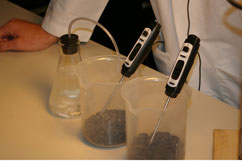 |

Developer, sponsor-promoter:
NEED: National Energy Education Development project
http://www.need.org/ Wikipedia: http://en.wikipedia.org/wiki/National_Energy_Education_Development_Project
Major NEED sponsors include: BP, Chevron,
Halliburton Foundation,
KBR, Shell, and
Society of Petroleum Engineers
http://www.need.org/Sponsors-Partners
|

Presentation as seen at an American science aquarium -- now, done now for years. With major funding by NEED sponsors.
Performed for visitors, tourists from across the U.S., as well as local school children during field trips.
|
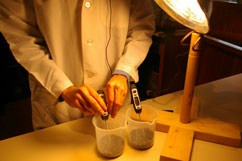
1.) Demonstration set up:
Side by side beakers, each with thermometer
and layer of pea gravel (rocks).
Shown above with lamp turned on.
|
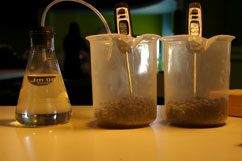
2.) Temperatures taken of air in both
beakers just above layer of rocks.
First with lamp off. Next, 100 watt lamp
turned on for 5 to 10 minutes, which heats up
the
rocks. Temperatures checked again.
|
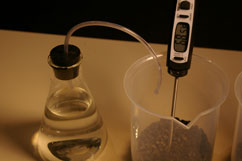
3.) Carbon Dioxide introduced into one of
the beakers:
Alka-Seltzer tablet is dropped
into water in Erlenmeyer flask. CO2 flows in
through tube, wafting into heated rocks,
then forms a lid of dense gas above rocks.
|
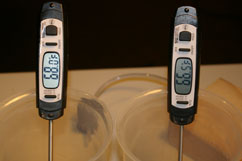
4.) After 5-15 seconds, temperature near
bottom of beaker with C02 rises 1-2 deg. F.
Presenter concludes the demo, stating:
"We have just
demonstrated for you
the greenhouse effect."
Is that really what happened?
|

A representative of the Mobile Climate Science Labs has discussed this demonstration on several occasions with aquarium
education staff and the
education manager --expressing deep concerns; requesting further discussion with aquarium senior staff.
The essential scientific flaws of this demo were discussed. No response addressing these concerns; we are aware of no change made to date.
Is educational material such as this being properly vetted? Do promoters have a responsibilty to recognize public feedback and peer review?
This is just one instance. What effect has this had? This demo is being promoted across the US, supported with substantial finances & influence.
|

Educational institutions and resources in the United States presenting or promoting this demo include:
Aquariums, k-12 schools,
teacher professional development workshops, websites, and newsletters.
NEED workshop calendar: http://need.org/calendar
Note: it has become a common practice to present educational materials without giving due acknowledgement and credit to their original creator.
This is not good academic etiquette
or protocol, and weakens science education, we feel. Demos are frequently presented without crediting the original developer(s).
Credit should be given where credit is due.
|
Flaws that exist with this widely promoted demo.
Based on our observation of scripted presentations by trained staff, review of on-line materials, questions asked, and lab & field test results.
|

General Flaws
|

Specific Scientific Errors
| 
Further questions and follow up
|
• Does not accurately represent
basic science in the
fields of energy, climate, physics, or chemistry.
• Simply does not demonstrate what it claims.
( This can be readily shown, using
basic and proper
lab techniques.)
• Has not been properly vetted.
• Effectively places teachers in the position of
spreading
disinformation.
• Not recommended for those who do not agree:
"It is
OK to present faked science education, as
long
as it
advances desirable opinions, political
positions or one's economic gains."
• Does not authentically meet state school science
education content
standards, especially for
investigation and experimentation requirements.
• Undermines reputation of public science education
institutions; invites ridicule and distrust.
• Invites doubt in the public's mind about the validity
of even fundamental scientific knowledge.
• Faulty case being heard: that "easy to do" and
inexpensive/sponsored demos always are the best
choice for what is presented in places of
learning.
• Diminishes science education. Tends to lower the
bar to whether students "believe in" global warming
or not. Can spell it. What about an accurate
understanding, deeper appreciation of importance,
opportunity to test & verify evidence? Being able to
have an authentic experience? Becoming actively
engaged in science, better prepared for a college, a
career and to be life-long active citizens. |
• Operates primarily by convection. Quite different
than the basic mechanisms in global warming and
what is customarily meant by the term "greenhouse
effect" in relation to CO2 and climate change.
== Wafting gas thru heated rocks past thermometer.
== Forming a layer of dense gas which stifles
convective heat transfer to the ambient air above.
• Does not account for properties of CO2 in
concentrated form; e.g. it is a gas denser than air.
• Claims are wildly out of line with what one would
expect in temperature rise, based on scientific
understanding. Does not explain this to participants.
Wrong phenomenon, embarrassingly wild results.
• Confuses the sequential steps by which global
warming is taking place.
• Confuses differences among bands of visible light
& IR energy. Fundamental in global warming.
• Encourages very poor lab techniques
== Beakers receive different amount of energy,
given the almost cavalier placement of lamp.
== Not comparing behavior of temperature sensors
under various conditions -- as a control, to calibrate.
== Obvious question not tested: is dissolving an
Alka Seltzer tablet a heat releasing, absorbing or
relatively neutral energy reaction?
== Not providing true controls. e.g. gas is
introduced in one beaker, and not in other.
Or, students could
compare temperature change
with
carbon dioxide next to the same experiment
using
argon gas. The latter is not a trivial
exercise;
in fact, it reveals
the most serious of the basic errors
in this demo's
design and premise.
|
• It seems incredible that major energy industry
sponsors would promote a lab experiment that
fosters
misunderstanding about science fundamentals
in their very field: energy. Surely, energy engineers
reviewed
materials in which the industry is making a
substantial
investment. This is "Energy Science 101"
material:
heat transfer by convection is different than
by
radiation. If American children are taught to
confuse
the two, what future does our country have
in
meeting its energy challenges? Are they being
readied to be tomorrow's engineers and scientists?
Are they able to decipher reality from illusion
in relation to energy science?
How could this have happened?
• How widespread has the promotion
of this flawed
demo by major sponsors been in terms of:
== Teachers trained?
== Number of schools in which taught?
== Science museums and aquariums presenting?
== Children instructed?
== Financial incentives given (direct and indirect)
== Educators laid off who question demo's validity?
== Other science education materials displaced?
== Damage to reputation of science research?
• Is it being disclosed to teachers and school
administrators, students and parents: What were the
legal entities that funded the development and
deployment of this demonstration? Do the aquariums
and science museums that have presented this
demonstration
disclose the funding they received in
connection with the decision to adopt this particular
demonstration?
Note: the subjects addressed by this demo are not
side issues in science education. A valid solution is
not to simply return to the position of discouraging
labs and demos from being offered in the public on
these topics. State science content standards
require these subjects be covered, and done so
hands-on. It is quite possible to do this with
accurate, not faulty hands-on science
experiments and investigations (labs and demos).
|

Testing and reviewing this demo -- in the lab and in the field
With kids, parents, teachers and scientists |

The Mobile Climate Science Labs has now brought this demo to the public on several occasions for testing and feedback.
In the San Francisco Bay Area, we recreated the set up and presented the demo,
repeating the basic script and steps followed
by trained presenters in programs funded by NEED sponsors.
We then turned it over to different groups: kids, kids and parents, teachers, teachers and students, scientists, scientists and kids. Our questions:
"What do you think of this demo? We are evaluating it, bringing it to you to assess."
"Is what is happening what we claimed in the presentation? If not, what is really going on?"
The kids and the scientists-with-kids groups typically were the first to discover the flaws. 5th grade students quickly suspected that the
demo operates via convection. Scientists generally were immediately skeptical of the demo's claims; some identified the flaws in seconds.
The immediate and dramatic temperature rise was a subject of laughter by many groups: "That is not the greenhouse effect!"
Admittedly, most of the learners in our test groups are able to draw from knowledge gained from lectures, multi-media resources,
internet research, shared family experiences
AND regular involvement in hands-on science education. They know their stuff.
Kids were able to use thermometers to support their hypothesis that the differential temperature rise is due to convection,
and the characteristics of denser-than-air concentrated carbon dioxide.
Further, as carbon dioxide dissipated, and the convection lids lower, marked temperature drops in the CO2 side were observed.
This, similar to Wagoner, Liu, and Tobin’s results.
|

For advanced placement students, we can recommend the demo after all!
We must thank and credit NEED, and its sponsors, for their contribution to climate science education.
This demo has proven to be a good lab to be used in the future – with students and the public...If done with these added features:
The Mobile Climate Science Labs will continue to utilize this and other demos to:
== Encourage skepticism and critical thinking. Be on the look out for deception and flawed arguments.
== Allow true experimentation & investigation. Let’s not accept authority blindly. Test and verify; think for yourself.
== How to indentify fakery, errors and incorrect assumptions. Climate scientists are required to do this; we can too.
== Come to appreciate just how robust climate science is. Very thoroughly tested; thousands of questions explored.
The basic mechanisms of global warming are especially well understood. (Better understood than how gravity works!)
== Help students become better scientists, engineers and educators.
== Gain a deeper understanding, and practical experience with: convection, conduction and radiation in the transfer of heat energy.
== Practice good lab techniques.
Other lab explorations we can recommend with this demo. We had success with these:
1.) Try introducing argon gas, similar to the way carbon dioxide enters through a tube. A source of argon gas must be available, of course;
it can not be easily generate as carbon dioxide can.
“Prove” argon is also a greenhouse gas! If one believes the premise of this demo, we can do that.
In reality, alas, argon is a molecule made of a single atom; there is no internal vibration within molecular bonds, as molecules with two or more atoms have.
Sadly, it can't be, and isn't a greenhouse gas. Argon, is however, heavier than air, just like carbon dioxide. It is the denser than air property that generates
the same
rapid temperature rise as witnesses with CO2 in the NEED produced demonstration. Forming a convection lid, just as in the demo.
It traps heat by muffling convection; not by the absorption of IR. To attribute this to the greenhouse effect would be to do another magic trick demo.
Thank you: Wagoner, Liu and Tobin for this idea, gained by study of your paper.
2.) Elevate the rocks well above the carbon dioxide. Place the heated rocks on a layer of mesh, half way up the beaker. Now, with the
thermometers below the rocks. (We like to also place temperature sensors within and above the rocks, to allow the public to investigate further.)
Introduce the carbon dioxide, this time below the rocks. What happened to the differential temperature rise????!!!
The CO2 is still receiving IR radiation from the rocks, why isn’t it heating up now? Why isn’t it heating faster than air as before?
There are several methods like this that work well to reveal how the demo is about convection in operation, not the IR radiation absorbing greenhouse effect.
The NEED demo is valuable after all. Educators, students and scientists alike can learn from its mistakes.
For demo developers and presenters,
this provides a memorable lesson: it is easy to get fake results if you are not careful. To design and polish a demo that is fun, safe, works well, and
looks easy, requires dedicated, thoughtful and careful efforts. Yet, we have a duty, as science educators, to never promote fake claims to the public.
-- review by: Mobile Climate Science Labs
|
|
